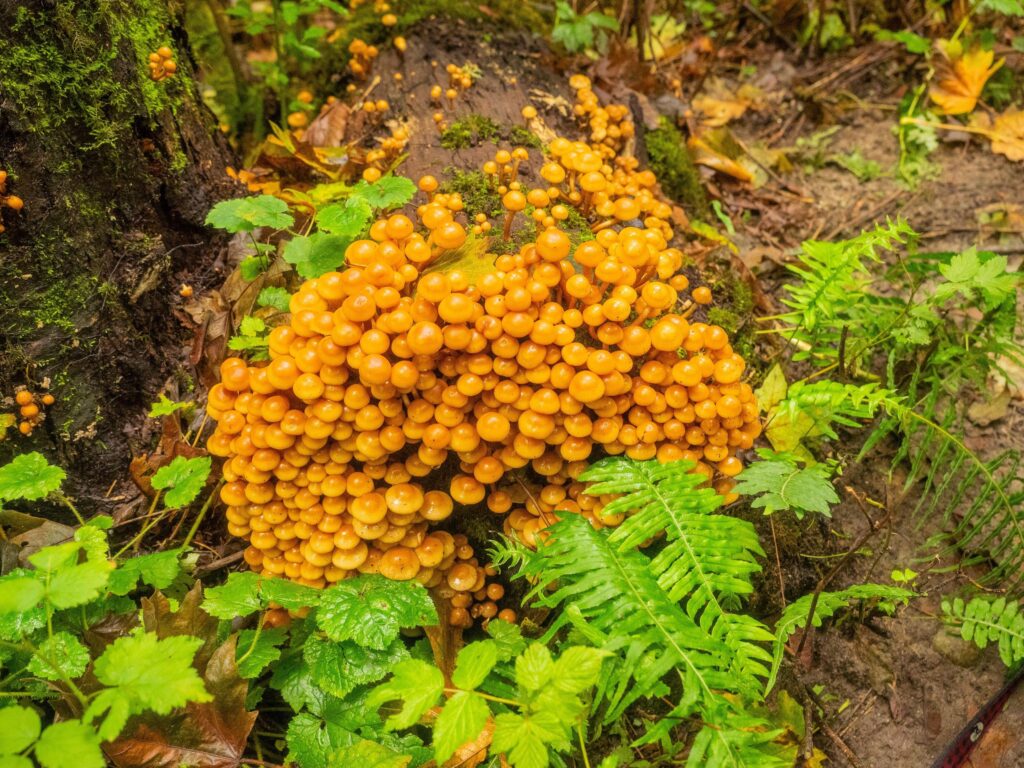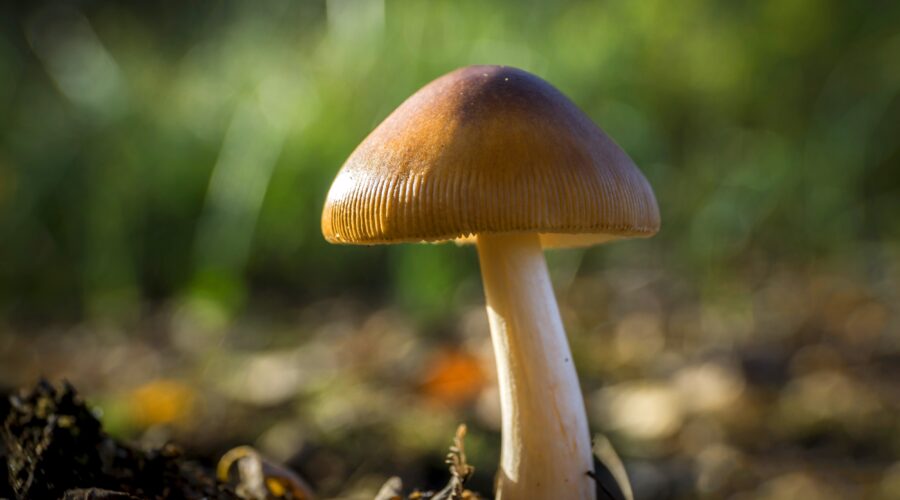Flying Saucer Mushrooms: Identification and Look-a-Likes of this Intense Shroom
Flying saucer mushrooms (Psilocybe azurescens) are one of the most potent species of psilocybin mushroom. This makes it a much sought-after psilocybin mushroom, as it can offer you much more bang for your buck.
Psilocybe azurescens grows in the wild and can also be easily cultivated outdoors. They’ve been given the name “flying saucer” because of the shape of the mushroom cap. These mushrooms belong to the genus Psilocybe, which is made up of 180 species.
RELATED: 10 Most Potent Magic Mushrooms
Identifying Flying Saucer Mushrooms And Their Lookalikes

To safely pick flying saucer mushrooms in the wild, you must know their exact appearance. Psilocybe azurescens resembles some mushrooms that can be poisonous or even deadly.
How To Identify Flying Saucer Mushrooms
You’ll be able to identify Psilocybe azurescens by knowing the distinctive features of the mushroom, which are as follows:
- Cap (pileus): 3-10 cm in diameter, conic to convex, expanding to broadly convex and eventually flattening in maturity. It has a pronounced, persistent, and broad umbo (a nipple-like structure in the middle of the cap). The surface of the cap is smooth and viscous when moist. And is covered by a separable gelatinous pellicle (the thin outer layer of a mushroom cap). Its color is chestnut to ochraceous brown to caramel, often becoming pitted with dark blue or bluish-black zones. The cap is also hygrophanous (it changes color based on the loss or absorption of water), fading to light straw color when dried. It strongly bruises blue when damaged. The margin of the cap is even, sometimes irregular and eroded when mature; it is slightly incurved at first, soon decurved, and flattening with maturity.
- Gills (lamellae): The gills are ascending, sinuate to adnate, brown, often stained blue or black where damaged, close, mottled, and with whitish edges.
- Stem (stipe): 9-20 cm long and 3-5 mm thick, silky white, dingy brown from the base, hollow at maturity, and made up of twisted, cartilaginous tissue. The base of the stem thickens downwards, is often curved, and features coarse tufts of mycelium, which often have azure tones. The mycelium surrounding the stem base is densely rhizomorphic (root-like) and silky white.
- Taste: Extremely bitter.
- Odor: Odorless to farinaceous (“flour-like”).
Here’s What People Like and Dislike About Flying Saucer Magic Mushrooms
| Likes | Dislikes |
|---|---|
| High Potency | Potency Variability |
| Known for their strong effects, providing a profound psychedelic experience. | Potency can vary significantly, making dosing challenging and potentially leading to unexpectedly intense experiences. |
| Therapeutic Potential | Physical Side Effects |
| Many users report beneficial effects on mental health, including relief from depression and anxiety. | Can cause nausea, headaches, and bodily discomfort, especially in higher doses. |
| Natural Growth | Identification Challenges |
| Can be found in the wild, appealing to foragers and naturalists. | Similar appearance to toxic species makes identification difficult for inexperienced foragers, posing risks. |
| Eco-Friendly Cultivation | Legal and Safety Concerns |
| Can be sustainably cultivated on wood chips or in natural settings. | Legal status is unclear or illegal in many areas, leading to potential legal issues. Use outside of a controlled, therapeutic context can pose safety risks. |
| Visual and Cognitive Enhancements | Emotional Intensity |
| Users often enjoy enhanced colors, patterns, and profound philosophical insights. | The intensity of emotions can be overwhelming, leading to challenging experiences or “bad trips.” |
| Community and Shared Experiences | Accessibility and Conservation |
| Shared use in certain settings can foster a sense of community and collective experience. | Overharvesting and habitat destruction can threaten wild populations, and access can be limited by legal restrictions. |
Where Do Psilocybe Azurescens Grow?
To identify flying saucer mushrooms in the wild, start by knowing their habitats and locations. Describe their preferred environments and list the countries and specific places where Psilocybe azurescens thrive.
Habitat
This species thrives in environments from caespitose (tight, separate clusters) to gregarious (scattered, irregular) among deciduous wood chips or in sandy soils filled with lignicolous (woody) debris.
It also favors coastal dune grasses. Fruiting starts in late September and lasts until late December or early January, as Stamets notes in “Psilocybin Mushrooms of the World” (1996).
Exciting news: Oregon is legalizing Psilocybin therapy in early 2023. Click here to get on the waiting list for the first state-approved psilocybin therapy in the United States now!
Distribution
Psilocybe azurescens naturally occurs in a narrow region of the US West Coast, covering areas in Oregon and California. It appears from Depoe Bay, Oregon, in the south to Grays Harbor County, Washington, in the north, mainly clustering around the Columbia River Delta.
Moreover, it is quite prevalent north of the Columbia River in Washington, from Long Beach north to Westport. And you can sometimes find it around decaying wood in the Williamette Valley of Oregon.
The small natural distribution of flying saucer mushrooms has encouraged a debate about whether they are, in fact, an introduced species to the area. Stamets, for instance, has suggested that they may have been introduced from debris washed down the Columbia from the old-growth forests upriver.
Psilocybe Azurescens Lookalikes
Flying saucer mushrooms are close relatives of Psilocybe cyanescens (wavy cap mushrooms), Psilocybe allennii, Psilocybe subaeruginosa from Australia, and New Zealand’s Psilocybe weraroa. They most resemble Psilocybe cyanescens and Psilocybe subaeruginosa. However, since Psilocybe subaeruginosa doesn’t naturally occur where flying saucer mushrooms do, mistaking it isn’t a concern.
Wavy caps share habitats with flying saucers, growing on wood chips in the Pacific Northwest. Accidentally picking and consuming wavy caps isn’t a major issue, as they are also potent, with similar recommended dosages.
Nonetheless, you will still want to ensure you that have the species you intend to collect.
To someone not trained, Psilocybe azurescens and other Psilocybe mushrooms might just look like typical little brown mushrooms (LBMs). However, knowing their specific characteristics can help you tell them apart from similar species.
Identifying them correctly is vital because some lookalikes, like Galerina marginata from the Galerina genus, are deadly due to amatoxins. Others may be poisonous.
Most Psilocybe mushrooms have dark purplish-brown to black spore prints, unlike the rust or cream spore prints of some lookalikes indicating poison. Doing a spore print is a good way to avoid picking and eating harmful mushrooms.
How To Grow Psilocybe Azurescens
Growing flying saucer mushrooms involves a similar process as growing any other type of magic mushroom, although they are harder to grow than other species, such as Psilocybe cubensis, which is known to be one of the easiest to grow.
If you’re a novice mushroom cultivator, growing Psilocybe cubensis may be a better option, as this will give you a higher chance of being successful. However, with care, attention, and patience, you can certainly cultivate Psilocybe azurescens indoors as well.
You should refer to our guide on how to grow psilocybin mushrooms at home for detailed instructions, but let’s now offer a quick summary of everything you need and the steps you should take.
Psilocybe Azurescens Spores
First, you need to source some Psilocybe azurescens spores. These are the reproductive cells that allow the mushroom to grow. Magic mushroom spores do not contain psilocybin, so they are not themselves illegal. But once they germinate and begin producing mycelium, psilocybin will be produced, making the end product illegal (since psilocybin is a controlled substance in most countries).
However, magic mushroom spores are illegal in California, Georgia, and Idaho. In the other 47 states, you’re free to buy and possess them.
There are different ways to obtain flying saucer mushroom spores. One way is to extract your spores from the mushrooms themselves.
The more popular option, though, is to buy them online from a vendor selling a spore syringe or print. The spore syringe is an oral syringe that contains just water and the wavy cap spores, while spore prints are little pieces of paper with the spores stamped onto them. The prints are dried and need to be rehydrated when you want to use them.
How To Grow Psilocybe Azurescens Indoors
It’s best to use our detailed guide for following the steps for growing magic mushrooms. You need the right ingredients, equipment, and hygiene supplies before getting started.
The necessary steps will then be:
- Preparing the jars
- Inoculation
- Colonization
- Preparing the grow chamber
- Fruiting
- Harvesting
- Drying the mushrooms for long-term storage (dried Psilocybe azurescens can retain their potency for around a year, whereas fresh mushrooms will only stay good for 5-10 days if kept in the fridge).
Growing Psilocybe Azurescens Outdoors
Our guide on growing magic mushrooms focuses specifically on doing so at home. Yet growing flying saucer mushrooms at home can be challenging since they require some specific conditions. Under the right conditions, however, they can easily grow outdoors.
If you want to grow Psilocybe azurescens outdoors, you need to keep certain things in mind.
Flying saucer mushrooms grow readily within mulched garden beds, as they like open shady areas, with reasonable moisture and deciduous trees. They are known to grow near rhododendrons, rose bushes, and azaleas. People have also discovered them growing among blackberry and thickets of Scotch Broom.
You can grow Psilocybe azurescens on a variety of wood-derived substrates such as Alder chips (Alnus rubra) or other woody mulches. You can also use cardboard or burlap.
To make growing them outdoors even easier, you can purchase a flying saucer mushroom grow kit. This would include woodchips colonized by Psilocybe azurescens mycelium, as well as a manual providing information on everything else you’ll need and instructions for growing.
Potency
As stated at the beginning of this article, Psilocybe azurescens is a highly potent species of psilocybin mushroom. It is one of the most potent magic mushrooms, in fact. This is due to its high concentration of psychedelic alkaloids.
To get a sense of its potency, let’s take a look at the concentrations of psilocybin and psilocin in several different species:
- Psilocybe azurenscens: 1.78 percent psilocybin and 0.38 percent psilocin
- Psilocybe semilanceata: 0.98 percent psilocybin and 0.2 percent psilocin
- Psilocybe cyanescens: 0.85 percent psilocybin and 0.36 percent psilocin
- Psilocybe tampanensis: 0.68 percent psilocybin and 0.32 percent psilocin
- Psilocybe cubensis: 0.63 percent psilocybin and 0.60 percent psilocin
Due to their potency, flying saucer mushrooms are a popular option for microdosing, as you only need to take a very small dose to feel the intended effects.
Also Read: Everything you need to know about Banded Mottlegill Mushrooms (Panaeolus Cinctulus)
Dosage
Because Psilocybe azurescens is a potent species, you will need to take a lower dosage compared to less potent magic mushrooms, assuming you want to get the same intensity of effects.
For example, Erowid lists the following dosages for Psilocybe cubensis, a medium-strength psilocybin mushroom:
- Threshold: 0.25 g
- Light: 0.25-1 g
- Common: 1-2.5 g
- Strong: 2.5-5 g
- Heavy: 5+ g
Based on the average psilocybin and psilocin content of flying saucer mushrooms, it is generally recommended to take about half the normal dose of Psilocybe cubensis.
The website Shroomery has its own Magic Mushroom Dosage Calculator, which can tell you how many grams of a particular species of magic mushroom you should consume based on how intense you want the experience to be.
With this in mind, as well as Erowid’s dosage recommendations for Psilocybe cubensis, the following dosages for flying saucer mushrooms are generally reliable:
- Threshold: 0.15 g
- Light: 0.15-0.5 g
- Common: 0.5-1.75 g
- Strong: 1.75-2.5 g
- Heavy: 2.5+ g
Duration Of Flying Saucer Mushroom Effects
A flying saucer mushroom trip will generally last between 4-6 hours. This duration is pretty consistent. In clinical trials involving psilocybin, most sessions will last up to six hours. After this time, the participants will no longer experience any psychedelic effects.
But the duration of a psilocybin experience for any individual depends on a few factors:
- Dosage: Taking a low dose of magic mushrooms could result in a trip lasting only a few hours, whereas consuming a high dose could lead to a six-hour experience.
- Method of Consumption: It takes around 30 minutes for shrooms to kick in. But you can quicken this process through lemon tekking — it is believed the citric acid in the lemon juice breaks down the mushroom material, saving your body some time it would otherwise spend breaking it down. The lemon tek method may result in a faster onset and a stronger and shorter journey than eating dried mushrooms as they are.
- Eating psilocybin mushrooms on an empty stomach can lead to a faster onset than consuming them on a full stomach.
- Cannabis may elongate a magic mushroom trip if you smoke it towards the end of the experience. This is because cannabis tends to potentiate the effects of psychedelics. Not everyone may experience this effect, however.
Psilocybin mushrooms have neither long-lasting nor short-lasting effects. Here is the duration of other psychedelics, so you can get a better sense of this:
- DMT: 5-30 minutes
- 5-MeO-DMT: 15-45 minutes
- LSD: 8-14 hours
- Mescaline: 8-16 hours
- Ibogaine: 8-24 hours
The duration of a mushroom trip is comparable to that of ayahuasca (also 4-6 hours). For many users, 4-6 hours of tripping is ideal; it means the experience is easier to fit into a day and less likely to interrupt sleep than, say, mescaline or LSD. But it is also not so quick and short-lived as the DMT and 5-MeO-DMT experiences are.



